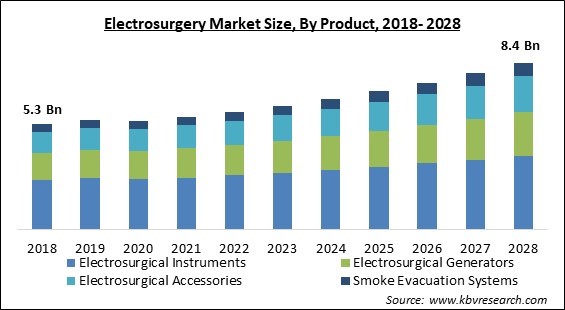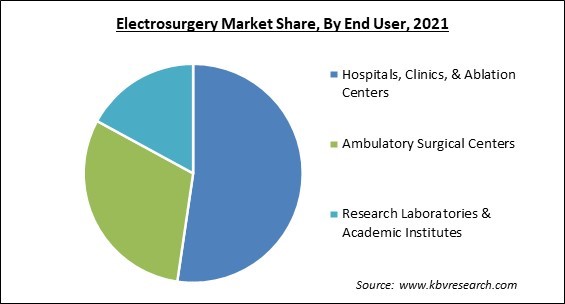The Global Electrosurgery Market size is expected to reach $8.4 billion by 2028, rising at a market growth of 5.9% CAGR during the forecast period.
A high-frequency (radio frequency) alternating polarity electrical current is applied during electrosurgery to biological tissue to cut, coagulate, desiccate, or fulgurate tissue. One of its advantages is that it allows for precision cutting with little blood loss. In hospital operating rooms or during outpatient treatments, electrosurgical devices are routinely utilized during surgical operations to assist prevent blood loss. An electric current heat the tissue during electrosurgical techniques.

Although electrical devices that generate a hot probe may be employed in some situations to cauterize tissue, electrocautery is not the same as electrosurgery. A probe heated to a high temperature by a direct electrical current is used in electrocautery. Direct current from dry cells in a penlight-style device may be used to achieve this. In contrast, radio frequency (RF) alternating current is used in electrosurgery to heat the tissue through RF-induced intracellular oscillation of ionized molecules, which raises the intracellular temperature.
Instantaneous cell death happens when the intracellular temperature hits 60 degrees Celsius. When tissue is heated between 60- and 99 degrees C, tissue desiccation (dehydration) and protein coagulation take place simultaneously. The intracellular contents go through a liquid to gas conversion, significant volumetric expansion, and subsequent explosive vaporization if the intracellular temperature quickly approaches 100 degrees C.
Electrosurgical forceps effectively block blood vessels and stop bleeding by using desiccation and coagulation. Inadvertently, carelessly, and inaccurately, electrocoagulation is often used to describe the procedure, even though it is technically an electrocoagulation procedure. As well as ablating tissue targets, a linear extension of the vaporization process can be used to transect or cut tissue.
The pandemic had a substantial impact on surgical practice. Every surgical specialty had to prioritize the urgency of their routine surgical procedures and, whenever practical, take non-surgical therapeutic options into account. Working methods, surgical procedures (open vs. minimally invasive), theatre workflow, patient and staff security, training, and education were all impacted by the pandemic. The pandemic caused a brief prohibition on elective surgery, which caused elective surgery cancellations everywhere. In a paper released by academics from the COVIDs Surge Collaborative, it was estimated that during the peak interruption of 12 weeks, around 28 million procedures were postponed.
The desire for minimally invasive and non-invasive surgical techniques over conventional surgical procedures has significantly increased during the past ten years. Over open surgical methods, minimally invasive surgeries provide several advantages, including quicker recovery times, lower post-operative problems, and less pain. Additionally, these techniques are less expensive than standard surgical procedures. For the treatment of several illnesses, including liver cancer, heart valve abnormalities, ophthalmic problems, and spine surgeries, laser and electrosurgical technologies are progressively being favored over traditional surgical treatments.
Government entities' primary focus on enhancing critical care infrastructure in their various healthcare systems is anticipated to assist the expansion of linked markets, such as the electrosurgery industry. Increasing healthcare spending on bettering infrastructure and lowering healthcare costs are two steps many industrialized countries' governments are attempting to improve their current healthcare systems. The federal government's increased support will likely accelerate market expansion.
High-frequency electrical currents are utilized during electrosurgical operations to cut and coagulate tissue. Electric shocks, thermal burns, the production of toxic gases, smoke inhalation, and the spread of infection are all possible side effects of the electrosurgical generator's heat. For instance, a patient in the US suffers burns during laparoscopic surgery every 90 minutes, according to Encision Inc. (US). Additionally, electrosurgical therapy for patients who have pacemakers and defibrillators implanted in their hearts may fail those devices. If sufficient precautions are not taken during the process, electrosurgery also carries a high risk of contamination.
Based on the Product, the Electrosurgery Market is divided into Electrosurgical Instruments, Electrosurgical Accessories, Electrosurgical Generators, and Smoke Evacuation Systems. The smoke evacuation systems segment witnessed a significant revenue share in the electrosurgery market in 2021. A surgical smoke evacuation system collects smoke aerosols and gases produced at the surgical site (ESU) by using high-flow vacuum sources.

On the basis of Surgery, the Electrosurgery Market is segmented into General Surgery, Obstetric/Gynecological Surgery, Orthopedic Surgery, Cardiovascular Surgery, Oncological Surgery, Cosmetic Surgery, Urological Surgery, Neurosurgery, and Others. The obstetric/gynecological surgery segment registered a substantial revenue share in the electrosurgery market in 2021. It is due to the women's lifestyles changing and how the body is responding to those changes.
By End-user, the Electrosurgery Market is bifurcated into Hospitals, Clinics, & Ablation Centers, Ambulatory Surgical Centers, Research Laboratories & Academic Institutes. The hospital, clinics, & ablation centers segment procured the highest revenue share in the electrosurgery market in 2021. The majority of all general and specialty procedures are done in hospitals, which is why demand is skyrocketing. Electrosurgery equipment is selling more and more in both new and established hospitals since they are a crucial component of any surgical setup.
| Report Attribute | Details |
|---|---|
| Market size value in 2021 | USD 5.7 Billion |
| Market size forecast in 2028 | USD 8.4 Billion |
| Base Year | 2021 |
| Historical Period | 2018 to 2020 |
| Forecast Period | 2022 to 2028 |
| Revenue Growth Rate | CAGR of 5.9% from 2022 to 2028 |
| Number of Pages | 303 |
| Number of Tables | 500 |
| Report coverage | Market Trends, Revenue Estimation and Forecast, Segmentation Analysis, Regional and Country Breakdown, Companies Strategic Developments, Company Profiling |
| Segments covered | Product, End User, Surgery, Region |
| Country scope | US, Canada, Mexico, Germany, UK, France, Russia, Spain, Italy, China, Japan, India, South Korea, Singapore, Malaysia, Brazil, Argentina, UAE, Saudi Arabia, South Africa, Nigeria |
| Growth Drivers |
|
| Restraints |
|
Region-wise, the Electrosurgery Market is analyzed across North America, Europe, Asia Pacific, and LAMEA. The North America region procured the highest revenue share in the electrosurgery market in 2021. Due to their advantages, such as smaller incisions, less scarring, better precision, reduced risk of complications, and quicker recovery times, among others, minimally invasive operations are becoming more and more popular in North America.
Free Valuable Insights: Global Electrosurgery Market size to reach USD 8.4 Billion by 2028
The market research report covers the analysis of key stake holders of the market. Key companies profiled in the report include Medtronic PLC, Boston Scientific Corporation, Johnson & Johnson (Ethicon, Inc.), Olympus Corporation, ConMed Corporation, Smith & Nephew PLC, Utah Medical Products, Inc., B. Braun Melsungen AG, Zimmer Biomet Holdings, Inc., and The Cooper Companies, Inc.
By Product
By End User
By Surgery
By Geography
The Electrosurgery Market size is projected to reach USD 8.4 billion by 2028.
Demand For Less Invasive Surgery Is Rising are driving the market in coming years, however, The Complications Of Electrosurgical Techniques restraints the growth of the market.
Medtronic PLC, Boston Scientific Corporation, Johnson & Johnson (Ethicon, Inc.), Olympus Corporation, ConMed Corporation, Smith & Nephew PLC, Utah Medical Products, Inc., B. Braun Melsungen AG, Zimmer Biomet Holdings, Inc., and The Cooper Companies, Inc.
The Electrosurgical Instruments segment acquired maximum revenue share in the Global Electrosurgery Market by Product in 2021 achieving a market value of $3.7 billion by 2028.
The General Surgery segment is leading the Global Electrosurgery Market by Surgery in 2021 thereby, achieving a market value of $1.9 billion by 2028.
The North America market dominated the Global Electrosurgery Market by Region in 2021, and would continue to be a dominant market till 2028; thereby, achieving a market value of $2.9 billion by 2028.
Our team of dedicated experts can provide you with attractive expansion opportunities for your business.

